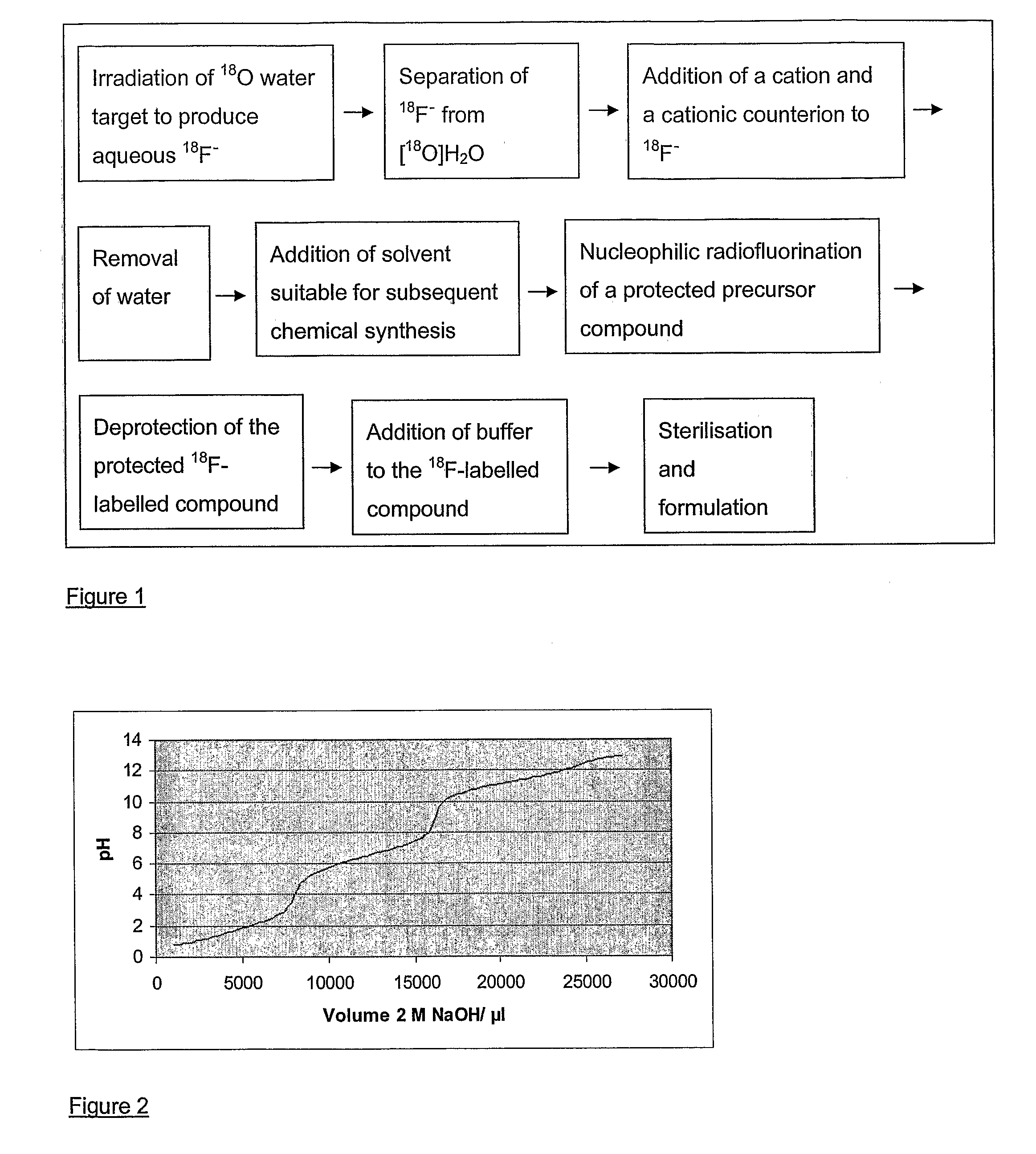Method of Deprotection
a technology of deprotection and labeling, applied in the field of radiosynthesis, can solve the problems of difficult to obtain the sup>18/sup>f-labelled tracer for clinical use in good radiochemical yield, and the synthesis of 18f-labelled compounds is relatively slow
- Summary
- Abstract
- Description
- Claims
- Application Information
AI Technical Summary
Benefits of technology
Problems solved by technology
Method used
Image
Examples
example 1
Analysis Of The Buffering Capacity Of Phosphoric Acid On Hcl Deprotected FDG Neutralised By Naoh
[0052]This example describes the experiment used to analyse the buffering capacity of phosphoric acid on HCl-deprotected FDG neutralised by NaOH.
[0053]A 16 μl aliquot of 0.15 g / ml of the protected precursor compound, tetraacetyl [18F]-FDG, in acetonitrile was added to a glassy carbon reaction vessel. This was heated to constant mass at 50° C. leaving 2.4 mg PFDG in the vessel. The vessel was sealed and pressure tested with approximately 2 bar of air. 2.5 ml of a 5M solution of HCl and 294 μl of 85% phosphoric acid was added and the vessel was heated to 145° C. for 15 minutes and then cooled. 0.5 ml of the reaction mixture was removed from the vessel and titrated against 1 M NaOH.
[0054]Titration of the HCl deprotected reaction mixture against 1 M NaOH revealed that the phosphate retains the pH within the range 4.5 to 6.3 from 1.47 ml to 1.63 ml NaOH.
example 2
Deprotection Of Protected FDG With 525 mg / ml Phosphoric Acid
[0055]This example describes the deprotection of protected FDG with 525 mg / ml phosphoric acid.
[0056]A 16 μl aliquot of 0.18 g / ml of the protected precursor compound, tetraacetyl [18F]-FDG, in acetonitrile was added to a glassy carbon reaction vessel. This was heated to constant mass at 50° C. leaving 2.8 mg pFDG in the vessel. The vessel was sealed and pressure tested with approximately 2 bar of air. 2 ml of a solution of 525 mg / ml phosphoric acid in HPLC grade water was added to the reaction vessel and heated to 145° C. and held at this temperature for 10 minutes and then cooled.
[0057]A portion was removed and titrated to approximately pH 8.0 with 5M NaOH.
[0058]HPLC analysis using 0.1 M NaOH mobile phase at 1 ml / min and electrochemical detection (ECD) was carried out on (i) standard FDG solution, (ii) the final reaction mixture and (iii) co-injection of (i) and (ii).
[0059]No precipitation was observed after the deprotectio...
example 3
Deprotection Of Protected FDG With 525 mg / ml phosphoric acid in 2M HCl
[0060]This example describes the deprotection of protected FDG with 525 mg / ml phosphoric acid in 2M HCl. A 16 μl aliquot of 0.11 g / ml of the protected precursor compound, tetraacetyl [18F]-FDG, in acetonitrile was added to a glassy carbon reaction vessel. This was heated to constant mass at 50° C. leaving 1.8 mg protected FDG in the vessel. The vessel was sealed and pressure tested with approximately 2 bar of air. 2 ml of a solution of 525 mg / ml phosphoric acid in 2M HCl was added to the reaction vessel and heated to 145° C. and held at this temperature for 10 minutes and then cooled.
[0061]A portion was removed and titrated to approximately pH 8.0 with 5M NaOH. HPLC analysis using 0.1 M NaOH mobile phase at 1 ml / min and ECD detection was carried out on (i) standard FDG solution, (ii) the final reaction mixture and (iii) co-injection of (i) and (ii).
[0062]No precipitation was observed after the deprotection reactio...
PUM
| Property | Measurement | Unit |
|---|---|---|
| Temperature | aaaaa | aaaaa |
| Molar density | aaaaa | aaaaa |
| Molar density | aaaaa | aaaaa |
Abstract
Description
Claims
Application Information
 Login to View More
Login to View More - R&D
- Intellectual Property
- Life Sciences
- Materials
- Tech Scout
- Unparalleled Data Quality
- Higher Quality Content
- 60% Fewer Hallucinations
Browse by: Latest US Patents, China's latest patents, Technical Efficacy Thesaurus, Application Domain, Technology Topic, Popular Technical Reports.
© 2025 PatSnap. All rights reserved.Legal|Privacy policy|Modern Slavery Act Transparency Statement|Sitemap|About US| Contact US: help@patsnap.com



